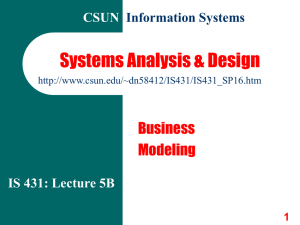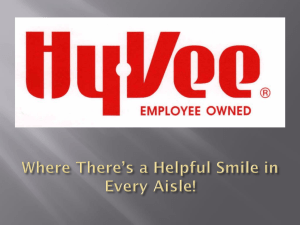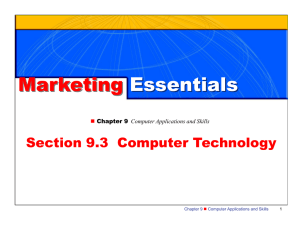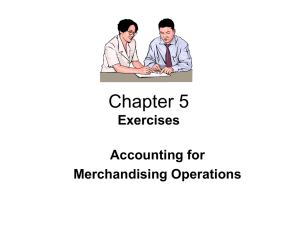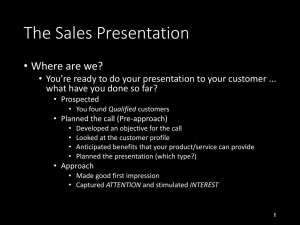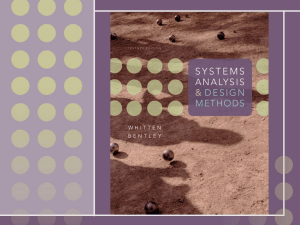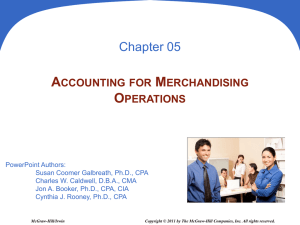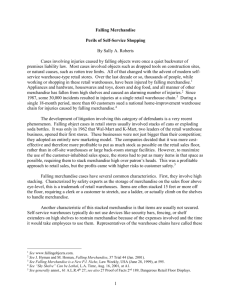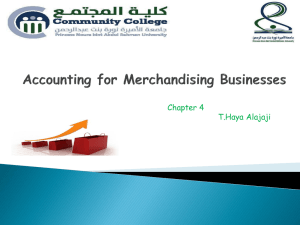Lecture1
advertisement
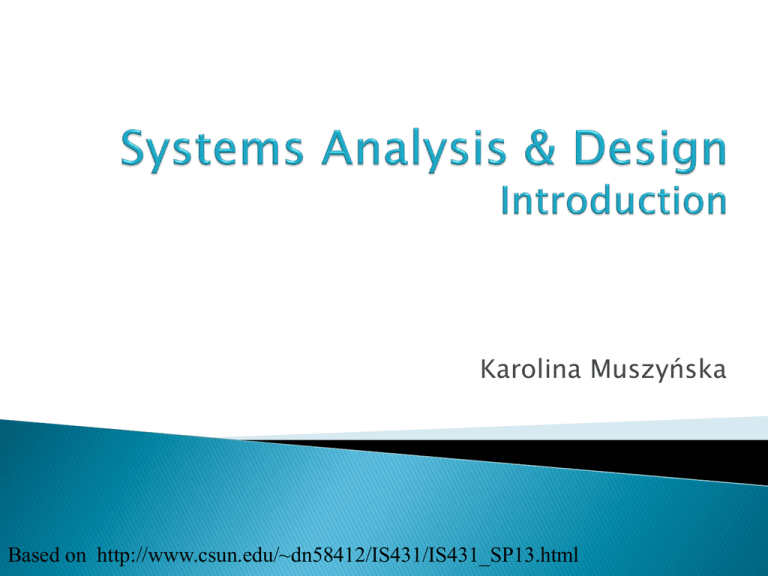
Karolina Muszyńska Based on http://www.csun.edu/~dn58412/IS431/IS431_SP13.html Information system applications - WHAT Information systems and their stakeholders – WHO Definition of a system Role of systems analysts Knowledge and skill set for system analysts IS Building Blocks Business modeling – why, what, how? 2 Information System (IS): People, data, processes, and information technology that interact to collect, process, store, and provide as output the information needed to support and improve operational, tactical, and strategic activities of an organization (business). Information Technology (IT): A combination of computer technology (hardware and software) with telecommunications technology (data, image, and voice networks) 3 Data – raw facts about people, places, events, and things that are of importance in an organization. Information – data that has been processed or reorganized into a more meaningful form for someone. Knowledge – data and information that is further refined based on the facts, truths, beliefs, judgments, experiences, and expertise of the recipient. Wisdom – when to apply a certain knowledge 4 5 Executive Level ◦ Long-term decisions (Strategies) ◦ Unstructured decisions (Competitions) Managerial Level ◦ Decisions covering weeks and months (Tactics) ◦ Semi-structured decisions (Effectiveness) Operational Level ◦ Day-to-day decisions (Operations) ◦ Structured decisions (Efficiency) 6 Information Systems in Organization STRATEGIC EXECUTIVE INFORMATION SYSTEMS TACTICAL MANAGEMENT INFORMATION SYSTEMS TRANSACTION PROCESSING SYSTEMS OPERATIONAL A C C O U N T I N G F I N A N C E H U M A N R E S P R O D U C T I O N S A L E S O T H E R S VALUE CHAIN 7 Information System in Context 8 Transaction Processing Systems Management Information Systems Executive Information Systems Decision Support Systems Expert Systems Functional Area Information Systems (Accounting, HR, Sales, Production …) Office Automation Systems (Personal Productivity Software) Collaboration Systems (Groupware) Enterprise Systems 9 Front-office information systems support business functions that extend out to the organization’s customers (or constituents). ◦ Marketing ◦ Sales ◦ Customer management Back-office information systems support internal business operations of an organization, as well as reach out to suppliers (of materials, equipment, supplies, and services). ◦ ◦ ◦ ◦ Human resources Financial management Manufacturing Inventory control 10 11 Stakeholder: any person who has an interest in an existing or proposed information system. Stakeholders can be technical or nontechnical workers. They may also include both internal and external workers. Information workers are those workers whose jobs involve the creation, collection, processing, distribution, and use of information. Knowledge workers are a subset of information workers whose responsibilities are based on a specialized body of knowledge. 12 Perspectives on an Information System 13 System owners – an information system’s sponsors and executives advocate, usually responsible for funding the project of developing, operating, and maintaining the information system. They define the SCOPE of a system: what business problem is to be solved ◦ They view the system in terms of cost/benefit to solve business problem 14 System Users System users – use or are affected by an information system on a regular basis – capturing, validating, entering, responding to, storing, and exchanging data and information. They define the REQUIREMENTS of the system. ◦ Internal users Clerical and service workers Technical and professional staff Supervisors, middle managers, and executive managers Remote and mobile users (internal but disconnected) ◦ External users 15 System designers translate system users’ business requirements and constraints into technical solution: computer databases, inputs, outputs, networks, and software meeting the system users’ requirements. Their activities relate to the DESIGN of a system System builders construct information systems based on the design specifications from the system designers. Their activities relate to building the COMPONENTS of the system. 16 Systems analysts study the problems and needs of an organization to determine how people, data, processes, and information technology can best accomplish improvements for the business. They are FACILITATORS of the system development project. • A programmer/analyst (or analyst/programmer) includes the responsibilities of both the computer programmer and the systems analyst. • A business analyst focuses on only the nontechnical aspects of systems analysis and design. 17 What “problems” to solve: (Project Definition) ◦ True problem situations, either real or anticipated, that require corrective action ◦ Opportunities to improve a situation despite the absence of complaints ◦ Directives to change a situation regardless of whether anyone has complained about the current situation Why: (Project Justification) ◦ Effective: Do right thing ◦ Efficient: Do thing right ◦ Competitive: Do thing differently 18 In traditional businesses ◦ Working in traditional information services organizations (permanent project teams) ◦ Working in contemporary information services organizations (dynamic project teams) In outsourcing businesses ◦ Contracted to traditional businesses In consulting businesses ◦ Contracted to traditional businesses In application software businesses ◦ Building software products for traditional businesses 19 20 Working knowledge of information technology Computer programming experience and expertise General business knowledge General problem-solving skills Good interpersonal communication skills Good interpersonal relations skills Flexibility and adaptability Character and ethics Systems Analysis and Design Skills 21 Information systems architecture - a unifying framework into which various stakeholders with different perspectives can organize and view the fundamental building blocks of information systems. 22 KNOWLEDGE (Data) — the raw material used to create useful information. PROCESSES — the activities (including management) that carry out the mission of the business. COMMUNICATION (Interfaces) — how the system interfaces with its users and other information systems. 23 24 System owners’ view ◦ Interested not in raw data but in information that adds new business knowledge and information that help managers make intelligent decisions. ◦ Data entities and business rules. System users’ view ◦ Something recorded on forms, stored in file cabinets, recorded in books and binders, organized into spreadsheets, or stored in computer files and databases. ◦ Focus on the business issues as they pertain to the data. ◦ Data requirement – a representation of users’ data in terms of entities, attributes, relationships, and rules independent of data technology. 25 System designers’ view ◦ Data structures, database schemas, fields, indexes, and constraints of particular database management system (DBMS). System builders’ view ◦ SQL ◦ DBMS or other data technologies 26 System owners’ view ◦ Concerned with high-level process called business functions ◦ Business function – a group of related processes that support the business. Functions can be decomposed into other subfunctions and eventually into processes that do specific tasks. (e.g. Sales Function) ◦ A cross-functional information system – a system that supports relevant business processes from several business functions without regard to traditional organizational boundaries such as divisions, departments, centers, and offices. (e.g. Production Function) 27 System users’ view ◦ Concerned with work that must be performed to provide the appropriate responses to business events. ◦ Business processes – activities that respond to business events. ◦ Process requirements – a user’s expectation of the processing requirements for a business process and its information systems. ◦ Policy – a set of rules that govern a business process. ◦ Procedure – a step-by-step set of instructions and logic for accomplishing a business process. ◦ Work flow – the flow of transactions through business processes to ensure appropriate checks and approvals are implemented. 28 System designers’ view ◦ Concerned with - which processes to automate and how to automate them ◦ Constrained by limitations of application development technologies being used ◦ Software specifications – the technical design of business processes to be automated or supported by computer programs (off-shelf, in-house) to be written by system builders. 29 System builders’ view ◦ Concerned with programming logic that implements automated processes ◦ Application program – a language-based, machinereadable representation of what a software process is supposed to do, or how a software process is supposed to accomplish its task. ◦ Prototyping – a technique for quickly building a functioning, but incomplete model of the information system using rapid application development tools. 30 System owners’ view ◦ Concerned with communications scope of an information system. Who (which business units, employees, customers, and partners) must interact with the system? Where are these business units, employees, customers, and partners located? What other information systems will the system have to interface with? System users’ view ◦ Concerned with the information system’s inputs and outputs (Interface Requirements). 31 System designers’ view ◦ Concerned with the technical design of both the user and the system-to-system communication interfaces. ◦ Interface specifications – technical designs that document how system users are to interact with a system and how a system interacts with other systems. ◦ User dialogue – a specification of how the user moves from window to window or page to page, interacting with the application programs to perform useful work. System builders’ view ◦ Concerned with the construction, installation, testing and implementation of user and system-to-system interface solutions. ◦ Middleware – utility software that allows application software and systems software that utilize differing technologies to interoperate. 32 System initiation – the initial planning for a project to define initial business scope, goals, schedule, and budget. System analysis – the study of a business problem domain to recommend improvements and specify the business requirements and priorities for the solution. System design – the specification or construction of a technical, computer-based solution for the business requirements identified in a system analysis. System implementation – the construction, installation, testing, and delivery of a system into production. 33 System Development as Problem Solving 34 An IS professional can add value in helping an organization to define and improve its business processes and design appropriate IS. What are business processes and how can they be designed to support an organization’s objectives? How do we design information systems that collect, maintain, and process the data needed to generate the outputs required by management to effectively manage business processes in the information age? REAL Business Process Modeling 35 Acquisition/Payment Conversion Business Process Business Process Human Resources Financial Resources Supplies Inventories Property, Plant and Equipment New Ideas (R & D) Miscellaneous services Operations (Varies widely depending upon the industry) Sales/Collection Business Process Marketing and Sales Service Promotion Outbound logistics Collection and Credit E-Commerce 36 Regardless of the type of good or service being acquired, the following are typical operating events in the acquisition/payment business process: ◦ ◦ ◦ ◦ ◦ ◦ Request goods or services. Order goods or services. Receive and inspect goods or services. Store and/or maintain goods. Pay for goods or services. Return goods. Specifics may vary 37 Although there is some diversity across the types of goods and services sold, the sales/collection process typically includes the following events: ◦ ◦ ◦ ◦ ◦ ◦ Receive an order for goods or services. Select and inspect goods or services to be delivered. Prepare goods or services for delivery. Deliver goods or services. Receive payment for goods or services. Accept customer returns of goods. Specifics may vary 38 General activities in the conversion process include: ◦ ◦ ◦ ◦ ◦ ◦ ◦ ◦ ◦ ◦ ◦ ◦ Assembling. Growing. Excavating. Harvesting. Basic manufacturing (e.g., metals, woods, and chemicals). Finished manufacturing (e.g., tools, instruments, components). Cleaning. Transporting. Distributing. Providing (e.g., power, water, protection, communication). Training. Discovering (e.g., research and development). 39 A business process is “a series of activities intended to accomplish the strategic objectives of an organization.” Operating Events are the operating activities performed within a business process to provide goods and services to customers. Information Events include three activities: recording data about operating events, maintaining reference data that are important to the organization, and reporting useful information to management and other decision makers. Decision/Management Events are activities where management and other people make decisions about planning, controlling, and evaluating business processes. 40 Event 1: Marketing Event 2: Take Customer Order Event 3: Ship the Goods Event 4: Collect Payment Business Process: Delivering Goods and Collecting Payment 41 Decision/ management events Define &Trigger Operating events Trigger Trigger Information events 42 Business events Information Needs of Decision Makers Record (event data) Trigger Trigger Information processes Maintain (agent, resource, location data) Information processes Report (in many formats) 43 Decision/Management Operating Events Analyzing the market, competitors, and customers. Deciding what pizzas to place on Golden’s menu. Determine if the cooked pizza is correct for presenting order form. Receive customer pizza order. Receive customer payment. Make pizza. Deliver pizza to customer. Trigger Information Events Generate a customer analysis report. Generate a report of sales by pizza type. Generate a gross margin analysis. Generate a report of lost sales (due to the 20 minutes guarantee.) Trigger 44 REAL Business Process Modeling is a formal method of identifying and representing the essential characteristics that collectively describe business processes and events. REAL = Resources, Events, Agents, and Locations. Preparing a REAL Business Process Model requires the identification of strategically significant business activities and essential characteristics about these business activities. 45 Step 1: Understand the organization’s Environment and Objectives Step 2: Review the business process and identify the strategically significant operating events Step 3: Analyze each event list in #2 to identify Resources, Events, Agents, and Locations Step 4: Identify the relevant behaviors, characteristics, and attributes of REAL Step 5: Identify and document direct relationships within REAL 46 REAL modeling is an aid in analyzing an organization and its activities. Collect data and insights about the organization’s objectives, industry, value chain, strategies, product lines, and customers. Pay attention to the organization’s people, structure, technologies, and measurements. A better understanding of these factors will enhance the evaluation of effective and efficient business processes valuable, competitive, meeting the organization’s objectives. 47 Industry Objectives The Company Competitors Strategies Technologies Measurements People Capital Technology Value Chain Structure Products Economic Forces Customers 48 Begin by dividing the organization into its business processes. “What happened? How and Why? ” REAL graphical model—include the strategically significant operating events that comprise a business process. (The ones that the organization wants to plan, evaluate and execute/or control) Begin REAL graphical model by representing events with a descriptor. 49 Events Sell merchandise Receive customer payment 50 Describe essential characteristics of the Events—the characteristics which: ◦ if omitted, would render an inaccurate or incomplete description of the event. ◦ form the basis for generating outputs for information customers to plan, execute, control and evaluate organization activities. What kinds of Resources were involved? What roles are performed and who/what Agents perform the roles? Where did the event occur? (Location) 51 RESOURCES/ LOCATION EVENTS Merchandise Sell Merchandise AGENTS Salesperson Register Cash Receive Customer Payment Customer 52 At what time or sequence in the process should the event occur? What are the exceptions to the “normal” ordering of events in the process? What is the proper authorization or approval to execute this event? What is a reasonable amount of resources associated with this event? What are the acceptable locations for executing this event? 53 What is an acceptable time period between events in a business process? How might the order of events vary by customer? Does the location from which goods are shipped matter? How many salespeople are assigned to each customer? Should a sales order clerk have custody of cash? 54 Ship merchandise Receive payment OR Receive payment Ship merchandise Provide Credit Cash in Advance The sequence of events may also be a function of the physical characteristics of the event (in production) Sometimes the sequence of events is dictated by business policy 55 Each sale takes place at a specific register (location). Each sale involves only one customer (external agent). Only one salesperson (internal agent) is responsible for each sale. Each sale involves one or more items of merchandise (resource). 56 Additional rules: ◦ The salesperson and customer do not have a direct relationship, The customer and salesperson are related only through the sale. ◦ Sales can only involve merchandise, not fixed assets. ◦ Sales cannot involve more merchandise (quantity) than McKool has on hand. ◦ Sales cannot involve merchandise McKool does not offer. ◦ The store keeps records on who sold which merchandize to whom at a specific cash register 57 Draw a line from each event to each resource, internal agent, external agent, and location associated with that event. On the line, add a meaningful term or phrase that describes the relationship between the objects. Graphically display events that are related to other events to show the required sequence of events in a business process. Draw lines from event to event in the correct sequence Document direct relationships between pairs of agents, locations, and resources that exist independently of an operating event. Connect the pairs with a line. 58 Merchandise Salesperson Sell Merchandise results in Register Customer Receive Customer Payment internal agent Cash 59 Business processes are linked together in two ways: ◦ sharing common resources or ◦ an event in one process triggering an event in another process. Collectively business processes result in the acquisition of goods and services the conversion of acquired goods and services into goods and services for customers the delivery of the goods and services to customers the collection of payment from customers. 60 Acquisition Inventory (Share a common Resource) Sales (One triggers another) Collection 61 Summary: A Model of Business Events Internal Agents Resources Event Location • • • • • External Agents What happened? When did it happen? Who was involved? What resources were involved? Where did it occur? 62 Resources Events Agents Inventory Sales Salesperson Customer Cash Cash Collection Cashier 63 Inventory M Include M M Sales Sell 1 Salesperson M M Sell to 1 Pay for M Cash 1 Include M Cash Collection 1 M Customer Receive from M Receive by 1 Cashier 64
